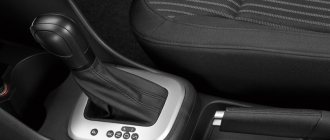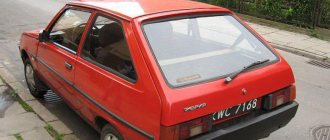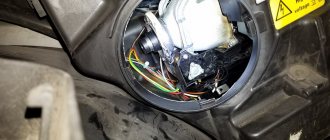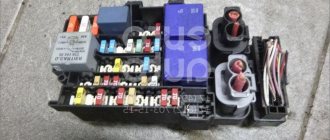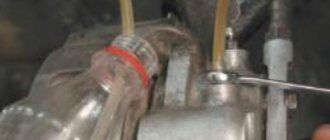To change the oil in DSG 7, we only need a 5-6 liter container, a standard set of tools, a filling syringe and a tube with a diameter of 7-8 mm. What’s nice is that during the replacement we don’t have to pump anything, squeeze anything out, the work is almost the same as with a regular manual transmission, with the exception of a few nuances.
And yet, when replacing, we will not remove either the starter, or the battery, or the battery platform. The only thing that will need to be removed is the engine protection. But even a child can cope with this. If everything is ready, we can start replacing:
- After removing the protection, thoroughly clean the Mechatronic unit from dirt.
- Use a 5mm hex to unscrew the drain plug.
- We place a container (about a liter) under the Mechatronic unit.
- Drain all the liquid from the control unit.
- Screw the drain plug into place.
- Now we clean the drain plug on the gearbox.
- Use a 10mm hex to unscrew the plug, replacing it with a container of about two liters.
- Let's wait until all the oil drains from the gearbox.
- We measure the amount of oil drained, since no inspection hole is provided.
- We tighten the gearbox oil drain plug.
- Now fill the oil into the Mechatronic control unit.
- Remove the plastic breather on the control unit from under the hood. It is located near the starter.
- To do this, we use a 16 key. We place the key under the breather and, like a lever, remove it from the hole.
- We put a hose with a diameter of 8 mm on the breather fitting, pour a liter of G004 000 M2 oil into the syringe and, using smooth movements of the piston, pump the oil into the mechatronics.
- If you don't have a refill syringe, you can use a 150 cc medical syringe or any other device. We put the breather in place.
- Now fill the gearbox with oil. We will also do this through the breather hole. To make it easier to get to it, we switch the gearbox control selector to Parking mode.
- Remove the plastic breather by hand.
- We put the same 8 mm hose on the breather fitting, fill the syringe with exactly the same amount of oil as we drained and pump it into the gearbox. After that we put the breather in place.
This way you can quickly change the oil in the DSG7 gearbox and the Mechatronic control unit on the Skoda Octavia A7. Good luck to everyone and have reliable gearboxes!
Transmission DSG7 (Direct Shift Gearbox) This is an Automatic Transmission of this type with dry clutches, developed by VW, which has seven gears and a reverse gear. Shifts occur without interrupting the flow of power (switching occurs without engaging neutral), this is the main advantage of Automatic Transmissions, and also provides a “creeping” mode at the beginning of movement. Therefore, DSG gearboxes are classified as automatic transmissions.
The leader in the production of “dry” clutches is VW; they immediately took into account the shortcoming of the DSG6 design of engaging forward and reverse gear with one clutch, and released a seven-speed transmission, where forward and reverse involve different rows.
DSG7 is equipped mainly in cars with a small engine capacity; on powerful engines with high torque, “dry” clutches cannot withstand. DSG7 is equipped mainly by Volkswagen, Skoda, also Audi, Seat.
Car models where you can find the DSG7 gearbox
A feature of the DSG7 is the presence of two volumes of oil, for the mechatronics that controls the DSG7 and the mechanical gearbox (where the forks, gears, etc. are). If on a conventional manual gearbox the clutch is clamped by design springs installed during manufacture, and when you press the clutch pedal, the clutch “releases”, thus no torque is transmitted, then in DSG7 the opposite happens, until the mechatronics gives the signal “released” to the clutches, they rotate freely , the mechatronics gives a signal, and the piston acts on the fork and the fork clamps the disk, and if there are no pressure leaks in the mechatronics, then the disk is clamped with the necessary force.
Diagnostic instruments contain the temperature value of the first and second friction disc; the temperature is calculated, i.e. how the clutch was slipping, how long, what torque was on the engine or what pressure was in the mechatronics, based on these readings the clutch temperature is calculated - this is the unmeasured temperature - this is the calculated temperature. If the calculated temperature begins to rise, it means that the clutch begins to slip excessively and the DSG7 gearbox will need to be repaired in the future.
Ford, Mercedes, Fiat have developed their DSG gearboxes with “dry” clutches. Ford abandoned hydraulics, installing electric motors, which are controlled by an electronic unit combined with electric motors, mounted on the box. Adaptation of the DSG7 Ford after replacing the electronic unit or double clutch is carried out automatically, unlike VW where it is necessary to carry out the adaptation procedure using special equipment.
The clutch in this box is a separate non-separable (non-repairable) unit. When replacing the clutch, the DSG7 is supplied by the manufacturer assembled, with adjusted disc clearances.
Classic problems with DSG7
The occurrence of defects in the operation of DSG7 is often associated with incorrect operation of the mechatronics
- There is no forward or reverse gear shifting,
- Jerks when changing gears.
After diagnostics, repair of the DSG7 mechatronics or its reprogramming is required. The reasons may be pressure leaks in the internal cavities, or incorrect operation of the gear shift software. Which leads to clutch slipping. Reprogramming the DSG7 is also required to update the software and optimize the operation of the box.
It is possible for the mechatronics unit to overheat in vehicle driving modes (providing a creeping mode) and, as a result, clutch discs to slip, subsequently repairing the DSG7, which is an operational defect in the operation of the DSG7. The manufacturer has recommended actions for DSG7 owners to force the transmission to switch from mode “D” to mode “N” when the car is in a traffic jam and stopped for more than 1 minute. VW developers did not count on the Russian specific operating conditions of the DSG7 (long hours of regular driving in traffic jams).
Also, failure of the DSG7 mechatronics is an oil leak from the “breather”; replacement or repair is required. If the electrical circuits inside the unit fail, the DSG7 mechatronics assembly is replaced.
Care must be taken to protect the exposed parts of the DSG7 from contamination. Failure of “dry” discs is possible for various reasons: Oil getting into the clutch (for example, due to a leak in the engine crankshaft oil seal), water, clogging of the clutch with dirt, etc. is a problem with a DSG7 gearbox with dry clutches.
The mechanical part of the DSG7 with high mileage is characterized by breakdowns of conventional manual gearboxes - gear failure, pitting of bearings, shafts, destruction of drive forks, etc. Then a thorough repair of the mechanical part of the box is required.
Replacing DSG6 with DSG7 is not possible, because transmissions are aggregated with different engines.
In 2011 During the production of DSG7, modifications were made to individual components, improvements were made, installation dimensions for clutches were changed, and the release bearing drive lever was changed.
Owners of cars with DSG7 are faced with problems with the automatic transmission
- jolts when shifting forward or backward,
- shocks when switching,
- automatic transmission vibration,
- slipping on shifts,
- the car turns on emergency mode.
The average operational mileage of a car with DSG7 is 90-150 thousand km. Repair and replacement of the clutch is carried out using special tools. Repairing the DSG7 requires strict adherence to the assembly and adjustment technology in accordance with the manufacturer's requirements.
Changing the oil in the DSG7 gearbox can only be done in the gearbox. Replacement can be done after an average of 40 thousand mileage or as needed, because The manufacturer fills in oil for the entire service life.
Released software updates are an advantage of the DSG7. At the first signs of improper operation of the DSG7, you should start with diagnostics and, if necessary, “reflash” the mechatronics if they were produced by the manufacturer for your car, but we do not recommend “reflashing” a normally operating DSG7.
Diagnostics and consultations on the DSG7 box
ATG service engineers provide technical support in the form of consultations on technical issues related to the repair and operation of the DSG7. You can get prompt advice by calling or sending a request from the company’s website
When diagnosing DSG7, many operating parameters can be checked using specialized test devices. Deciphering and analyzing the received gearbox operation codes allows you to find the cause of incorrect automatic transmission operation and prevents DSG7 breakdown by timely detection of defects. One of the points of DSG7 diagnostics is to monitor the clutch temperature in operating modes. Clutch wear can be viewed programmatically.
Checking for leaks and changing the oil can be done at the ATG service center and is a necessary procedure aimed at maintaining the automatic transmission in working technical condition, in order to increase its trouble-free operation.
ATG has special tools and equipment and can carry out all restoration work. We have experience in competent, qualified maintenance and repair of DSG7 automatic transmissions in Moscow.
Question 001: Q: What is DSG? What types of DSG are there? What is the difference? What cars are they installed on? A: DSG (from German DirektSchaltGetriebe or English Direct Shift Gearbox) is a family of preselective robotic transmissions with dual clutches installed on VAG cars (Audi, Volkswagen, Skoda, Seat).
| Type | Clutches | Engine location | Engine sizes | Drive unit | Moment | What car models can it be installed on? |
| DSG7 0AM (DQ200) | "dry" | transverse | 1.2 -1.8 | front | 250Nm | Audi: A1, A3 (8P - until 2013), TT; VW: Golf6, Jetta, Polo, Passat, Passat CC, Scirocco, Touran, Ameo; Skoda: Octavia (1Z - until 2013), Yeti, Superb, Fabia, Roomster, Rapid; Seat: Altea, Leon (1P - until 2013), Toledo. |
| DSG6 02E (DQ250) | "wet" | transverse | 1.4 — 3.2 | front/full | 350Nm | Audi: A3 (8P - until 2013), TT, Q3; VW: Golf, Passat, Touran, Scirocco, Sharan, Tiguan; Skoda: Octavia (1Z - until 2013), Yeti, Superb; Seat: Altea, Leon (1P - until 2013), Toledo, Alhambra. |
| DSG7 0B5 (DL501) | "wet" | longitudinal | 2.0 — 4.2 | full | 550Nm | Audi: A4 (until 2020), A5, A6, A7, Q5, RS4, RS5. |
| DSG7 0BT/0BH (DQ500) | "wet" | transverse | 2.0 — 2.5 | front/full | 600Nm | Audi: Q3, RS3, TTRS; VW: Transporter/Multivan/Caravelle, Tiguan. |
| DSG7 0CW (DQ200) | "dry" | transverse | 1.2 — 1.8 | front | 250Nm | Audi: A3 (8V - from 2013), Q2; VW: Golf7, Passat (from 2020), Touran (from 2020); T-Roc. Skoda: Octavia (5E - from 2013), Rapid (from 2013), Karoq, Scala (from 2020); Seat: Leon (5F - since 2013). |
| DSG6 0D9 (DQ250) | "wet" | transverse | 1.4 — 2.0 | front/full | 350Nm | Audi: A3 (8V - from 2013), Q2; VW: Golf7, Passat (from 2020), Touran (from 2020); Skoda: Octavia (5E - from 2013), Kodiaq; Seat: Leon (5F - since 2013), Ateca. |
| DSG7 0DL (DQ500) | "wet" | transverse | 2.0 | front/full | 600Nm | VW: Arteon, Passat (from 2020), Tiguan (from 2020); Skoda: Kodiaq. |
| DSG7 0GC (DQ381) | "wet" | transverse | 2.0 | front/full | 420Nm | Audi: A3 (from 2020), Q2; VW: Arteon, Golf (from 2020), Passat (from 2017); T-Roc. Skoda: Karoq; Seat: Ateca. |
| DSG7 0CK (DL382-7F) | "wet" | longitudinal | 1.4 — 3.0 | front | 400Nm | Audi: A4 (8W - from 2020), A6 (from 2011), A7 (from 2020), Q5 (from 2013). |
| DSG7 0CL (DL382-7Q) | "wet" | longitudinal | 2.0 — 3.0 | full | 400Nm | Audi: A4 (8W - from 2020). |
| DSG7 0СJ | "wet" | longitudinal | 2.0 | full (Ulta Quattro, with electromechanical clutch) | 400Nm | Audi: A4 (8W - from 2020). |
Looking at the table, we can draw some simple conclusions: 1. DSG with “dry” clutches, as a rule, are installed on less powerful engines, because
are able to “digest” a smaller moment. 2. If you have all-wheel drive, then you have “wet” clutches. 3. If you have a DSG and a longitudinal engine, then you have an Audi :-) 4. Apparently, the age of the legendary Audi Quattro all-wheel drive with the famous Torsen differential is coming to an end. Question 002:Q: How can I find out which gearbox is installed on my car? A: Option 1: Connect to the car with a diagnostic tool, go to block 02 - Transmission electronics and read the identification data. The first three characters of the box and mechatronics identifiers identify your box. For example: 0AM 300049H - seven-speed DSG with dry clutches type 0AM. Or 02E 300051R - six-speed DSG with wet clutches like 02E, etc. Option 2: Look by the vehicle's VIN code in the ETKA electronic spare parts catalog. Option 3: Send the vehicle's VIN code to our address, we will check and send you an answer. Question 003: Q: How does S-tronic for Audi differ from DSG for Volkswagen/Skoda/Seat? A: Nothing. With the exception of boxes 0B5, 0CK/0CL and 0СJ which are installed only on audio. Question 004: Q: What kind of oil is poured into the DSG? A: For convenience, we have formulated the answer in the form of a table:
| Type | Oil | Replacement interval (manufacturer's recommendation) |
| DSG7 0AM (DQ200) | for the entire service life | |
| DSG6 02E (DQ250) | Filling volumes: up to 6.9l - full filling up to 5.5l - oil change Filter element: 02E 305 051 C | 60 000 |
| DSG7 0B5 | Gearbox oil DSG G 052 529 up to 7.5 l - full filling up to 6.7 l - oil change Filter element: 0B5 325 330 A | 60 000 |
| DSG7 0BT/0BH (DQ500) | Gearbox oil DSG G 052 182 up to 7.6 - full filling up to 6.0 l - oil change Filter element: 0BH 325 183 B | 60 000 |
| DSG7 0CW (DQ200) | In the box: Gearbox oil G 052 512 — 1.9 l In mechatronics: Hydraulic oil G 004 000 — 1 l | for the entire service life |
| DSG7 0D9 (DQ250) | In the box: Gearbox oil DSG G 052 182 Filling volumes: up to 6.9 l - full fill up to 5.5 l - oil change Filter element: 02E 305 051 C In the transfer case: G 052 145 - 0.9 l | 60 000 |
| DSG7 0DL (DQ500) | In the box: Gearbox oil DSG G 052 182 Filter element: 0BH 325 183 B In the transfer case: G 052 145 | 60 000 |
| DSG7 0GC (DQ381) | ATF oil: G 055 529 | 60 000 |
| DSG7 0CK (DL382-7F) | ATF oil: G 055 549 A2 4.35l - full filling 3.5l - oil change | 60 000 |
| DSG7 0CL (DL382-7Q) | ATF oil: G 055 549 A2 4.35l - full filling 3.5l - oil change MTF oil: G 055 529 A2 - 3.8l | 60 000 |
Question 005:Q: What is mechatronics?
A: Mechatronik (mechatronik, mechatron, valve body, brain) - electronic-hydraulic control unit for the gearbox. Perhaps the most important, but at the same time the most unreliable unit in the entire transmission. Question 006: Q: What is the difference between mechatronics? A: Each type of DSG has its own type of mechatronics. Mechatronics from different types of DSG are not interchangeable. Moreover, for some types of DSG there are several generations of mechatronics, which also differ from each other. And for each type and generation of mechatronics, there are many versions of software designed for different engines and different gear ratios in the gearbox. In some cases, mechatronics of the same type can be reprogrammed (reflashed) for installation on different vehicles. You can read more about the firmware. Question 007:Q: Which DSG is better/more reliable? A: There is no clear answer to this question. Each type of DSG has its own advantages and disadvantages. And the “life” of any DSG largely depends on its operating conditions, such as: - Ambient temperature. All DSGs do not like overheating, especially for DSGs with “dry” clutches, in which the mechatronics have a separate oil circuit and there is no cooling; — Driving mode. Those who spend several hours every day in traffic jams have a greater chance of coming to replace mechatronics than those who mainly drive long distances on the highway; — Driving style. For those who like to “give the corner” and “light up at traffic lights”, the likelihood of having to replace the clutch and differential is much higher than for those who prefer a quiet ride. Question 008:Q: I have DSG7 0AM. Do I need to switch the selector to neutral when standing at a traffic light or in a traffic jam? A: No need. Unlike conventional manual gearboxes, the DSG7 0AM has a normally open clutch. And it closes only when the mechatronics begins to extend the clutch release rods. When you (or autohold) press the brake and hold the car in place, the mechatronics clutch rods are retracted and the clutches are open. Accordingly, no load is transferred to the gearbox or clutch. It doesn’t matter what position the selector knob is in. Question 009:Q: Over time, jerks appeared when changing gears. Previously, the car drove normally, the shifts were smooth, but recently there have been jerks and bumps when changing gears. Can this be fixed by reprogramming the transmission ECU (software update)? A: No you can't. The software cannot “deteriorate” over time and cause the CP to malfunction. If the car previously drove correctly, and then stopped, then the problem lies in the hardware, and not in the software. Reprogramming the mechatronics can only help if the mechatronics were changed and a unit with incorrect software was installed. You can read more about reprogramming. Question 010:Q: How to find out the software version in mechatronics? Question 011:Q: The DSG7 gear shift knob is locked in position P, how to unlock it in order to shift the gearbox to neutral? A: Brief instructions for unlocking the DSG7 0AM selector.
Question 012:Q: Will changing the oil in the DSG7 0AM(0CW) mechatronics help eliminate “kicks” during gear shifts? A: No, it won't help. Such malfunctions can be eliminated by repairing the hydraulic part of the mechatronics. In the initial stages, adaptation (basic installation) can help, but as an exception rather than a rule.
Question 014:Q: After replacing the mechatronics DSG7 0AM, the event recorder displays errors “06247 P1867 - Drive data bus, no messages from the steering column electronics - J527” and “06227 P1853 Drive data bus, unreliable message from the ABS control unit.” How to remove them? A: It is necessary to reset information about installed components (steering column switches, electric parking brake, etc.). To do this, you need to make a basic installation on channel 69. After completing the basic installation, the errors will go from the “constant” state to the “sporadic” state and they can be deleted.
When using VCDS software (VAG-COM, VASYA-Diagnostic, etc.): “02-Gearbox Electronics” -> “Basic. parameters - 04" -> In the "Group" field enter the value 69 -> Click "Read".
When using VAS-PC software: “Self-diagnosis” -> “02-Gearbox electronics” -> “006-Basic installation” -> In the “Group” field, enter the value 69 -> Press “Q”.
When using ODIS software: “Self-diagnosis” -> “02-Gearbox electronics” -> “Basic installation” -> Enter the value 69 -> Click “Channel selection”.
After the basic installation, you should clear the event recorder.
Question 015:Q: Structurally, DSG7 0AM and DSG7 0CW are almost identical transmissions (DQ200 family), is there any difference between the mechatronics installed on them? A: The main difference is the physical and software changes to the electronic control board. In particular, 0CW boards are tied to the vehicle immobilizer system. You can read more about the differences in mechatronics 0AM and 0CW.
Car SEAT Leon Copa Plus. Bundle 1.8TSI+DSG7+ABS+ESP+EBD.
Robotic gearbox DSG-7
,
DQ200
,
0AM
,
NTQ
.
We purchase original VAG gear oil, order code - G052512A2
. The gearbox drain plug is unscrewed with a regular 10mm hexagon.
Photo-1:
DSG-7 cross-section.
If they were damaged, then the plug code is N10037105
. Both items were taken from the catalog by VIN number.
We learned how to change the oil from Alexander WillWillis from Drive2.ru. He explains and shows everything clearly. A couple of additions from us. If you have never removed the air filter housing, check in advance how this is done. On the 1.8 TSI, to remove it, you need to carefully pull it up, because... it sits tightly on the two mounting pins of the battery platform, and there are rubber dampers in the mounting holes of the filter housing. And one moment. We drained 1.7 liters of used oil from the DSG7 box and filled in all 2 liters.
The oil change in DSG-7 was performed at a mileage of 76,000 km. What made us do this? Doubts! There are doubts that the technical fluid in constantly contacting gearbox parts can last the entire life of the vehicle and maintain its performance characteristics. 2 years warranty - yes, transmission oil can work. So what is next? What if the machine has been used for 5-7 years? We think not. Gearbox oil is not capable of operating for such a long period of time without losing its physical and chemical characteristics. That's why they made the replacement. The result of the work is below.
| Photo-2: metal particles in used oil from DSG7. Mileage 76 thousand km. | Photo-3: once again metal particles in the used oil from DSG7. |
| Photo-4: color of used oil from DSG. The bottle stands in front of the sun's rays and is not translucent. The photo was taken without flash. | Photo-5: comparison of fresh and used DSG7 oil by color. The photo was taken with flash. |
| Photo-6: comparison of fresh and used DSG7 oil by color. Photo taken without flash |
According to subjective feelings, we did not do the oil change procedure in vain. The box began to switch very softly, barely noticeable.
19.07.2016
After changing the oil in the gearbox, 4 months have passed and 6000 km have been driven. No problems arose during this time: there were no leaks, no fogging due to filling 2 liters of oil. The car accelerated once to 200 km. at one o'clock.
Our conclusion: the oil in the mechanical part of the DSG-7 needs to be changed. How often? We believe that once every 60 thousand km.
The manufacturer itself states that the DSG robot is highly reliable and is an advantageous solution compared to traditional hydromechanical automatic transmissions or CVTs. One way or another, it is important to understand that this box requires regular and high-quality maintenance, taking into account a number of features of its design.
Such maintenance should be understood, first of all, as changing the oil in the DSG, as well as the DSG. Next, we will talk about when the oil in the DSG needs to be changed, how the oil in the DSG box is changed, and also what to pay attention to during this procedure.
Read in this article
Changing transmission oil in a DSG robot: when is it needed and why
So, the specified gearbox is based on a manual transmission, as well as (by analogy with a manual transmission). In other words, unlike “classic” automatic transmissions or a variator, there is no torque converter.
There are two clutch discs, making gear shifts very quickly and smoothly. The result is a high level of comfort and fuel efficiency, as well as impressive acceleration dynamics, since there is virtually no interruption in the power flow during shifts, etc.
Controls the operation of the gearbox and clutch, as well as (analog). In fact, the electronic unit sends signals to the actuators, after which, due to the redistribution of fluid (oil) flows in the mechatronics, gears are engaged and other processes are controlled.
It is quite obvious that the presence of such a device as mechatronics means increased requirements for the quality and condition of transmission oil. In other words, a timely oil change in the DSG gearbox is necessary.
Let us immediately note that according to the regulations, an oil change in the DSG-6, and also often in the DSG-7, is required every 60 thousand km. However, if the car is operated in difficult conditions (trailer towing, aggressive driving, maximum loads), the transmission oil needs to be replaced earlier (the interval is reduced by 20-30 or even 40%).
Please note that DSG-6 is and can last about 200-250 thousand km. without repair. At the same time, it is important to understand that the vast majority of DSG breakdowns that occur are the result of untimely replacement of the oil in the gearbox along with violation of operating requirements for the gearbox.
Also, after an oil change, most owners note that after the change, for example, in the DSG-6, the shocks when switching disappear, the gearbox operates smoothly, without jerking. Next, we will look at the process of changing the oil in the DSG-6 with our own hands.
What happens if you don't change the oil?
The role of transmission fluid is to clean parts and protect them from premature wear. The oil covers all surfaces with a thin film, preventing excessive friction and abrasion. This effect is achieved through the use of a liquid having a certain composition and viscosity.
Over time, foreign impurities appear in the transmission fluid, including tiny particles of metal that can scratch parts. In addition, the oil becomes more liquid, so it does not stay on the surface of the parts as well as fresh oil. The conclusion is obvious: all gearbox parts begin to deteriorate much faster, so the need for repairs may arise even during the first hundred thousand mileage.
How to select and change oil in DSG
So, in order to change the oil in the DSG, you must first select a special transmission fluid or oil for the DSG box that is suitable for units of this type. To change the oil in a DSG box, for example, DQ-250, you will need 6 liters of gear oil.
Considering that such a gearbox has a “wet” clutch (clutch packs are immersed in an oil bath), in this case more oil is needed. As for the DSG-7 with the so-called “dry” clutch, such a box requires less transmission fluid.
We also note that in addition to the fluid, it is necessary to change the oil filter of the DSG box, as well as the special sealing ring of the drain plug. As a rule, when replacing, original oils and transmission fluids with VW TL52182 approvals are used. You can also select suitable analogues from third-party manufacturers.
The main thing is to use high quality products as well. If we talk about the replacement itself, you can either use the services of specialized service stations or perform all the manipulations yourself.
- First of all, in addition to the oil and gearbox filter, you will need a garage with an inspection hole or a lift, a set of tools, containers for draining waste, rags;
- Before starting the replacement, the box must be warmed up by driving the car for about 10 km;
- Next, the machine is placed on a pit or raised on a lift; if present, the engine protection is removed;
- Then you will need to remove the air intake along with the air filter, battery with casing and pan;
- Next, the plastic cup is unscrewed and the filter is removed;
- Then you need to remove the breather cap (located closer to the headlight from the filter);
- Now you can go down under the car and unscrew the drain plug, place a container into which the waste will be drained;
- After unscrewing the plug, an allen key is inserted into the hole, which is used to unscrew a special insert. This allows you to drain the maximum amount of oil;
- After removing the insert, you need to wait until all the oil has drained into the container;
- At the same time, you need to saturate the new DSG box filter with fresh oil. To do this, you can insert the filter into the cup housing and pour oil into it;
- After the oil has completely drained from the gearbox, the insert can be screwed in, but there is no need to screw in the drain plug. If you screw it in, the oil will be poured into the unit faster;
- To avoid oil leaks, place a container in the area of the drain hole.
- Now all that remains is to insert a funnel into the gearbox breather (from above under the hood) and fill in fresh oil. You should pour slowly and carefully, dosing portions.
Let us also add that you can fill the oil in other ways (for example, pump it with a syringe through the drain hole), but in practice, filling through the breather is the fastest and most effective. Also, after about 4.5 liters of oil have been poured into the box, you need to tighten the gearbox oil filter cap, replace the breather cap, install the previously removed elements of the engine intake system, and connect the terminals to the battery.
There is no need to tighten or tighten anything yet. At the same time, the old gearbox drain plug is installed (we are not installing a new one yet, and the o-rings are not changing either). Next, you need to start the engine, connecting in parallel to the ECU via.
The main task is to wait until the oil in the DSG warms up to 40-48 degrees. After such heating, there is no need to turn off the engine; however, the old drain plug should be unscrewed. It is important that the oil drips slightly from the hole as a result of the vibrations of the running engine.
Then you need to wait some time until the excess flows out, that is, the required amount remains in the gearbox (a plug insert installed in the drain hole will not allow more lubricant to leak out). Please note that if, when you unscrew the plug, the oil does not immediately drip, this indicates that it is not filled enough and needs topping up.
Once the oil stops dripping, this will indicate the required oil level in the gearbox. In this case, you can screw in a new plug with an o-ring and also turn off the engine. Now you can begin reassembly by tightening all previously removed and unscrewed elements. At this point, the oil change can be considered complete.
Get to work
So, first you need to drive the car into the inspection hole. Then you should turn off the engine, having previously set the gearbox selector to “parking” mode. After this, unscrew the drain plug of the box pan. To do this you will need an 8mm hex socket. Pre-prepare an empty container for old oil with a volume of about five liters. It is advisable that it be clean (you need to determine whether there are chips in the old fluid). After draining the old oil, tighten the plug and inspect the condition of the fluid. If metal particles are detected, increased wear of the box elements can be noted. Such a gearbox may be unstable.
After this you need to get to the oil filter. It is located higher. To get it, you will have to remove the battery and the platform under it.
If access is difficult, you can also remove the air filter housing with pipes. Then unscrew the cap two turns and allow the remaining oil to drain into the crankcase. Then unscrew the cap completely and replace the filter element.
